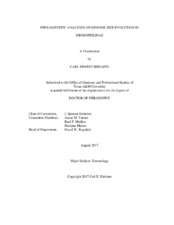| dc.description.abstract | Genome size varies widely across organisms with no tie to organismal complexity. While much of the variation in genome size can be attributed to accumulation of nongenic DNA, the patterns and mechanisms involved are not fully understood. While many hypotheses have been proposed to explain the patterns, they often ignore evolutionary relationships. I address this issue through the analysis of genome size utilizing comparative phylogenetic methods. I compare the results to expectations for different hypothesized modes of genome size change in Drosophilidae. In addition to analyses of whole genome size, I ask how separate components of the genome, sex chromosomes and heterochromatin level, may contribute to these patterns. I conclude the accordion model is the best fit and discuss how chance and adaptations might have acted to produce the genome size variation we observe today.
New and updated genome size for 93 Drosophila species were produced using flow cytometry, with a focus on the Drosophila subgenus. I used this data, plus additional published data, to produce a phylogenetic analysis of genome size evolution in 152 species of Drosophila. Genome size was found to have complete phylogenetic signal and gradual change, with evidence for some change temporally early. These patterns for whole genome size change were consistent throughout the entire genus, with only subtle differences between the subgenera. Components of genome size, however, provided different patterns. While there was no difference between the patterns in females and males, the heteromorphic sex chromosome shows reduced phylogenetic signal with evidence for rapid change along individual branches. This is supportive of a loss of DNA on the Y chromosome and consistent with hypotheses for Y chromosome turnover through neo-Y systems. Knowing that Drosophila melanogaster exhibits thoracic underreplication (a stalling of the first round of replication before heterochromatic DNA is fully replicated), I scored the percentage of underreplication for approximately 100 Drosophila species. Phylogenetic patterns for replicated euchromatin and underreplicated heterochromatin were analyzed. Interestingly, I found that the underreplicated DNA exhibits change late in the phylogeny, suggesting an adaptive role. In the future, these patterns must be compared to other life history characteristics. | en |


